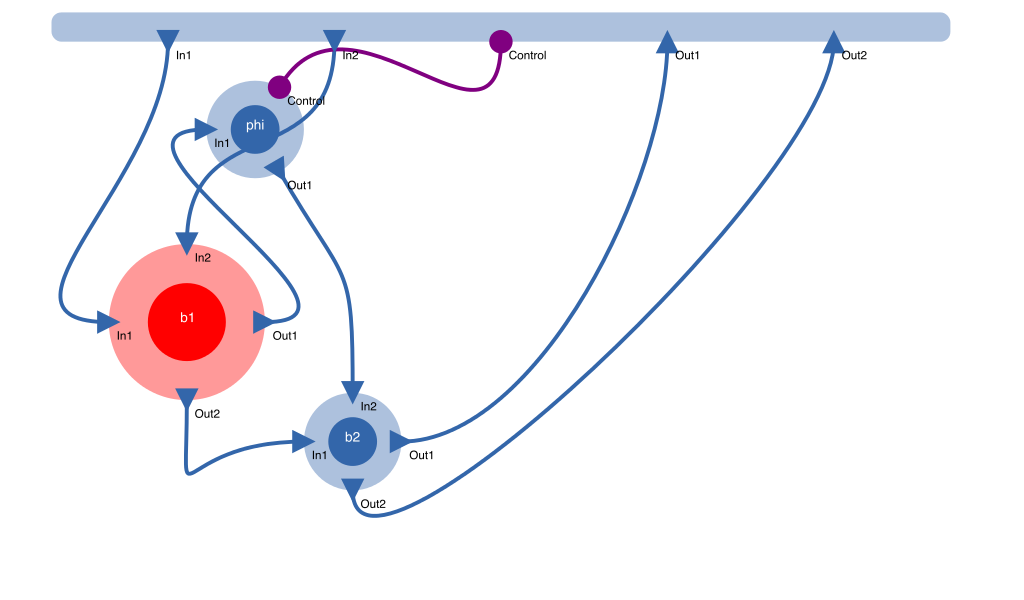Visually editing circuits with cirq
Cirq is a package for creating and editing circuits of arbitrary domain.
The very simple data structure allows for interfacing with further modeling and
simulation backends.
Circuits, i.e., abstract networks of interconnected components with ports, have found application in various scientific and engineering domains, ranging from applications close to the physical implementation, such as electrical circuits, photonic circuits for optical information processing, superconducting circuits for quantum information applications to more abstract circuit representations of dynamical systems, modeling biological processes or even software algorithms.
Their great applicability has already led to the development of many domain- specific modeling and simulation toolkits as well as some very general domain-independent toolkits such as Modelica, but to date, there exist very few open source graphical general circuit editing environments that can be tightly integrated with custom, domain-specific implementation simulation or analysis backends as well as IPython.
An in-browser visual circuit editor leads to a rich integrated simulation and analysis workflow in which an engineer or researcher can receive very fast feedback when making changes to his model. As a consequence, it is much easier to build intuition for the particular kinds of circuit models and find novel and creative solutions to an engineering task.
Check out the talk I gave at SciPy 2014 in Austin here.
Check out (download to see actual circuits)
- Demo.ipynb to see how to use cirq
- Ahkab.ipynb to see how to interface cirq with Ahkab
- QNET.ipynb to see how to interface cirq with QNET
This file is actually based on the first one of these.
import cirq; reload(cirq);
from cirq import *
init_js()
<IPython.core.display.Javascript at 0x108f0af90>
import cirq.tests; reload(cirq.tests);
cirq.tests.test_mach_zehnder()
Let's assume an example from my field, the connections are given by directed
propagating light fields.
Directed connections are called causal. Moreover, each input can only be
connected to a single output
due to reasons of unitarity of the underlying physics. All energy/information
must be accounted for.
This is indicated by the one2one keyword, which only applies to domains with
causal=True.
To provide an additional example, we also define an electrical domain, which is undirected/acausal and we will draw its ports and connections in purple.
fm = Domain(name="fieldmode", causal=True, one2one=True)
el = Domain(name="electrical", causal=False, _color="purple")
fm, el
(Domain(name=fieldmode, causal=True, one2one=True),
Domain(name=electrical, causal=False, one2one=False))
We now specify some port instances that will be re-used by multiple component types by cloning them, because each port can only belong to a single component.
Inputs = [Port(name="In{}".format(k+1), domain=fm, direction="in") for k in range(5)]
Outputs = [Port(name="Out{}".format(k+1), domain=fm, direction="out") for k in range(5)]
el_port = Port(name="Control", domain=el, direction="inout")
Inputs, Outputs, el_port
([In1, In2, In3, In4, In5], [Out1, Out2, Out3, Out4, Out5], Control)
We now define two different component models. A Beamsplitter,i.e., a semi- transparent mirror which interferometrically mixes two input beams, and an optical phase shifter, that can be controlled electronically.
BS = ComponentType(name="Beamsplitter", ports=clone_ports(Inputs[:2]+Outputs[:2]))
Phase = ComponentType(name="Phase", ports=clone_ports(Inputs[:1]+[el_port]+Outputs[:1]))
b1, b2 = map(BS.make_instance, ["b1", "b2"])
phi = Phase.make_instance("phi")
mz = Circuit(name="MachZehnder",
ports=clone_ports(Inputs[:2]+[el_port]+Outputs[:2]),
component_instances=[b1,b2,phi])
mz.connections = [Connection(source=s, target=t)
for (s,t) in [
(mz.p.In1, b1.p.In1),
(mz.p.In2, b1.p.In2),
(b1.p.Out1, phi.p.In1),
(b1.p.Out2, b2.p.In1),
(phi.p.Out1, b2.p.In2),
(b2.p.Out1, mz.p.Out1),
(b2.p.Out2, mz.p.Out2),
(mz.p.Control, phi.p.Control)]]
mz
from IPython.html.widgets import interact
@interact(r=(20,200))
def resize_b1(r=ComponentInstance._r.default_value):
b1._r = r
b1.layout_ports(b1.ports)
cb = CircuitBuilder([fm, el], [BS, Phase], mz)
cb
from IPython.display import Image, FileLink, SVG
cb.circuit.capture_svg()
cb.circuit.save_last_image("mach_zehnder.svg")
cb.circuit.save_last_image("mach_zehnder.png")
cb.circuit.save_last_image("mach_zehnder.pdf")
# this needs to run in another cell, because the above method writes the SVG file asynchronously
display(SVG(filename="mach_zehnder.svg"),
Image(filename="mach_zehnder.png"),
FileLink("mach_zehnder.pdf"))
mz.to_jsonifiable()
{'component_instances': {u'b1': u'Beamsplitter',
u'b2': u'Beamsplitter',
u'phi': u'Phase'},
'component_types': {u'Beamsplitter': {'ports': [{'direction': 'in',
'domain': u'fieldmode',
'name': u'In1'},
{'direction': 'in', 'domain': u'fieldmode', 'name': u'In2'},
{'direction': 'out', 'domain': u'fieldmode', 'name': u'Out1'},
{'direction': 'out', 'domain': u'fieldmode', 'name': u'Out2'}]},
u'Phase': {'ports': [{'direction': 'in',
'domain': u'fieldmode',
'name': u'In1'},
{'direction': 'inout', 'domain': u'electrical', 'name': u'Control'},
{'direction': 'out', 'domain': u'fieldmode', 'name': u'Out1'}]}},
'connections': [(u'MachZehnder', u'In1', u'b1', u'In1'),
(u'MachZehnder', u'In2', u'b1', u'In2'),
(u'b1', u'Out1', u'phi', u'In1'),
(u'b1', u'Out2', u'b2', u'In1'),
(u'phi', u'Out1', u'b2', u'In2'),
(u'b2', u'Out1', u'MachZehnder', u'Out1'),
(u'b2', u'Out2', u'MachZehnder', u'Out2'),
(u'MachZehnder', u'Control', u'phi', u'Control')],
'domains': {u'electrical': {'causal': False, 'one2one': False},
u'fieldmode': {'causal': True, 'one2one': True}},
'name': u'MachZehnder',
'ports': [{'direction': 'in', 'domain': u'fieldmode', 'name': u'In1'},
{'direction': 'in', 'domain': u'fieldmode', 'name': u'In2'},
{'direction': 'inout', 'domain': u'electrical', 'name': u'Control'},
{'direction': 'out', 'domain': u'fieldmode', 'name': u'Out1'},
{'direction': 'out', 'domain': u'fieldmode', 'name': u'Out2'}]}
mz2 = Circuit.from_jsonifiable(mz.to_jsonifiable())
mz2
mz.get_nets(fm)
[[MachZehnder.p.In1, b1.p.In1],
[MachZehnder.p.In2, b1.p.In2],
[MachZehnder.p.Out1, b2.p.Out1],
[MachZehnder.p.Out2, b2.p.Out2],
[b1.p.Out1, phi.p.In1],
[b1.p.Out2, b2.p.In1],
[b2.p.In2, phi.p.Out1]]
mz.get_nets(el)
[[MachZehnder.p.Control, phi.p.Control]]
Copyright (c) 2014, Nikolas Tezak Nikolas.Tezak@gmail.com All rights reserved.
Redistribution and use in source and binary forms, with or without modification, are permitted provided that the following conditions are met:
-
Redistributions of source code must retain the above copyright notice, this list of conditions and the following disclaimer.
-
Redistributions in binary form must reproduce the above copyright notice, this list of conditions and the following disclaimer in the documentation and/or other materials provided with the distribution.
-
Neither the name of Cirq nor the names of its contributors may be used to endorse or promote products derived from this software without specific prior written permission.
THIS SOFTWARE IS PROVIDED BY THE COPYRIGHT HOLDERS AND CONTRIBUTORS "AS IS" AND ANY EXPRESS OR IMPLIED WARRANTIES, INCLUDING, BUT NOT LIMITED TO, THE IMPLIED WARRANTIES OF MERCHANTABILITY AND FITNESS FOR A PARTICULAR PURPOSE ARE DISCLAIMED. IN NO EVENT SHALL THE COPYRIGHT HOLDER OR CONTRIBUTORS BE LIABLE FOR ANY DIRECT, INDIRECT, INCIDENTAL, SPECIAL, EXEMPLARY, OR CONSEQUENTIAL DAMAGES (INCLUDING, BUT NOT LIMITED TO, PROCUREMENT OF SUBSTITUTE GOODS OR SERVICES; LOSS OF USE, DATA, OR PROFITS; OR BUSINESS INTERRUPTION) HOWEVER CAUSED AND ON ANY THEORY OF LIABILITY, WHETHER IN CONTRACT, STRICT LIABILITY, OR TORT (INCLUDING NEGLIGENCE OR OTHERWISE) ARISING IN ANY WAY OUT OF THE USE OF THIS SOFTWARE, EVEN IF ADVISED OF THE POSSIBILITY OF SUCH DAMAGE.
